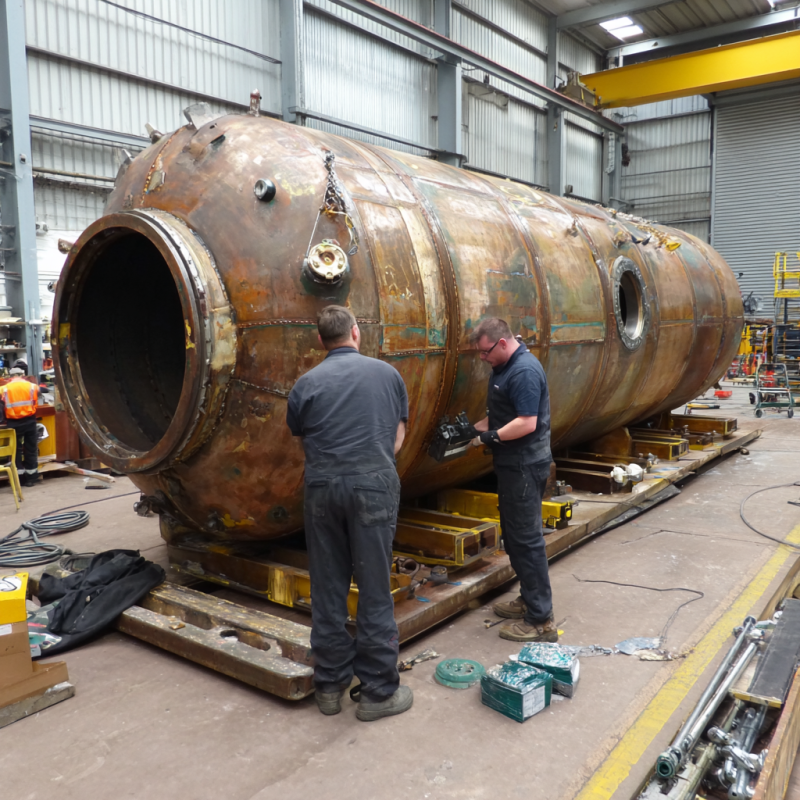
Understanding What is Pressure Vessel Manufacturing Inspection
A Complete Guide to What is Pressure Vessel Manufacturing Inspection
If you have ever wondered what is pressure vessel manufacturing inspection, you are looking at the thorough evaluation process that ensures vessels holding pressurized gases or liquids comply with strict industry standards. During this process, inspectors review everything from material traceability to weld quality. They check that each component meets or exceeds codes such as ASME (American Society of Mechanical Engineers) guidelines. This level of detail helps keep you safe and keeps your facility running efficiently.
Pressure vessel manufacturers like Red River place a strong emphasis on open communication and prompt handling of any issues. Their goal is to blend safety with consistent quality. By documenting every aspect of the vessel’s construction (including the smallest weld), they help you avoid unexpected downtime and costly repairs. That means you get a safe, long-lasting pressure vessel you can rely on.
Explore why inspection matters
Inspections matter because they offer peace of mind and real-world assurance. Pressure vessels operate under high or volatile pressures, which makes a compromised component risky to both workers and equipment. An ASME certification is one sign that a vessel went through extensive checks. Another danger in skipping inspections is that small flaws often grow into bigger problems. For instance, a missed crack in the weld can become a major leak that halts operations.
At Red River, inspections are built into every manufacturing step. Materials are tested for compliance and durability, ensuring long-lasting vessels. Each check protects your investment. A single failure can cost millions and create liability risks. Most importantly, inspections safeguard workers, preventing injuries or fatalities and making them both a business and moral necessity.
Examine the key inspection steps
A complete inspection process typically covers the following stages:
- Material verification: You confirm that the metals and components match the required standards. For instance, if you are using stainless steel, inspectors ensure it meets the specified grade and thickness.
- Nondestructive testing (NDT)
Techniques like radiographic (X-ray) or ultrasonic testing spot internal flaws without cutting into the vessel. You get a clear view of weld integrity and material soundness. - Dimensional checks
Inspectors measure each part against design drawings. Even small deviations can lead to stress points or misalignment. - Pressure testing
Hydrostatic or pneumatic tests apply pressure above normal operating levels, revealing leaks or faults. This step verifies the vessel can safely handle its intended load. - Documentation review
A final check confirms all paperwork (including traceability records) matches what is physically built. At Red River, full traceability ensures you can track every component back to its source.
If you are curious about how the vessel moves from raw materials to a finished product, you can explore broader details at pressure vessel fabrication. Fact-based inspections remain a key part of this bigger fabrication story.
Quality Control Documentation and Certification
Beyond physical testing procedures, comprehensive documentation serves as the backbone of pressure vessel manufacturing inspection. Inspectors compile detailed reports that include material certificates, welding procedure specifications (WPS), welder qualification records, and photographic evidence of each inspection phase. This documentation package becomes your vessel’s “passport,” proving compliance with ASME codes and other regulatory requirements.
Red River keeps detailed records, including inspection checklists, calibration certificates, and inspector signatures. These documents support certification, audits, insurance, and long-term traceability, proving compliance and manufacturing quality. Proper documentation also streamlines maintenance and repairs, giving technicians quick access to specifications and history. This reduces downtime, ensures regulatory compliance, and provides valuable data to optimize performance and extend service life.
How prefabrication streamlines inspections
Prefabrication can simplify your inspection routine. When pressure vessel components (or entire modules) are built in a controlled factory setting, you reduce on-site exposure hours and potential errors caused by environmental factors. According to Red River, consistent quality checks are easier when engineers and inspectors can collaborate in the same location. If something does not line up, the fix happens before shipment, saving you time and money on the job site.
Factory-built sections are tested in a stable environment with materials and vendors nearby, boosting efficiency. By the time your vessel arrives, major inspections are complete, leaving only final checks before installation. Fabrication facilities regulate conditions, protect welding, and use specialized equipment for precision. Continuous oversight and coordinated inspections ensure higher quality, faster issue resolution, and fewer project delays.
What is Pressure Vessel Manufacturing Inspection
Understanding what is pressure vessel manufacturing inspection means recognizing how vital it is for both safety and quality. Each step ensures your vessel meets industry requirements, operates reliably, and enjoys a long service life. Whether you run a chemical plant or a small processing facility, inspections safeguard your operations, your bottom line, and your team’s well-being.
Proper inspection protocols serve as your first line of defense against catastrophic failures, costly downtime, and potential safety hazards. The investment in thorough manufacturing inspection pays dividends through reduced maintenance costs, extended equipment life, and peace of mind knowing your pressure vessels can handle demanding industrial applications safely and efficiently.
Modern inspection techniques continue to evolve, incorporating advanced technologies like digital radiography, automated ultrasonic testing, and real-time monitoring systems. These innovations enhance detection capabilities while streamlining the inspection process, ultimately delivering higher quality vessels in shorter timeframes.
For expert capabilities in pressure vessel manufacturing and inspection, or to learn more about Red River’s comprehensive solutions, feel free to contact our team. You can also request a quote to discuss your specific project requirements. This comprehensive approach ensures every weld, bolt, and seal is ready for daily demands.
Need a reliable partner?
Red River specializes in the design and manufacturing of pressure vessels. We also fabricate related items such as prefabricated spools and modular skids.
Reach out to us today and experience the Red River difference. Where American-made products and American Values come together, we care more.
Frequently Asked Questions
1. What is pressure vessel manufacturing inspection?
Pressure vessel manufacturing inspection is the process of verifying that a vessel is designed, fabricated, and tested in compliance with industry codes (such as ASME Section VIII) and customer requirements. It includes checking raw materials, welding quality, heat treatment, dimensional accuracy, non-destructive testing (NDT), hydrostatic testing, and final certification. The goal is to ensure safety, reliability, and regulatory compliance before the vessel enters service.
2. How often should pressure vessels be inspected?
The inspection frequency depends on local regulations, industry standards, and service conditions. In general:
- External inspection: at least once a year to check for leaks, corrosion, or damage.
- Internal inspection: typically every 3–5 years, or more often if the vessel operates under harsh conditions.
- Regulatory standards: for example, OSHA and ASME jurisdictional rules often dictate minimum inspection intervals.
Always follow the specific code of jurisdiction and the vessel’s service history.
3. How do you inspect a pressure vessel?
Inspection involves a combination of visual, mechanical, and non-destructive testing methods:
- Visual examination : checking welds, surfaces, and joints for cracks, pitting, or corrosion.
- Ultrasonic or radiographic testing : to detect internal flaws or thickness loss.
- Hydrostatic or pneumatic testing : verifying vessel strength under pressure.
- Surface methods (dye penetrant, magnetic particle) : for detecting surface cracks.
- Documentation review : ensuring compliance with design drawings, material certificates, and test records.
A certified inspector typically performs these tests according to ASME, API, or local standards.
4. Which certifications matter for quality inspection?
ASME stamps and NBBI accreditations confirm the vessel and inspection process meet recognized safety and quality guidelines.
5. Why is material traceability so important?
Traceability allows issues to be traced back to the source material, aiding accountability and preventing future problems.
6. Can I inspect my vessel myself?
Basic visual checks can be done in-house, but certified professionals should handle formal inspections.
7. When should I replace a vessel rather than repair it?
If repair costs exceed value or the vessel no longer meets codes, replacement is the safer choice.
Key takeaways
- A thorough inspection process checks materials, dimensions, welds, and pressure capacity.
- Prefabrication environments improve efficiency, reduce rework, and streamline on-site checks.
- Documentation and traceability are cornerstones of a reliable inspection.
- Industry certifications (like ASME) confirm that rigorous quality standards are met or exceeded.
- Ongoing inspections and timely repairs help you maintain consistent performance over a vessel’s lifetime.
